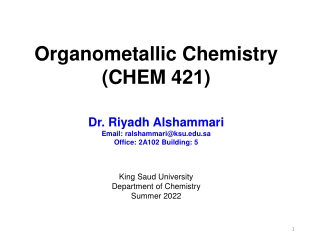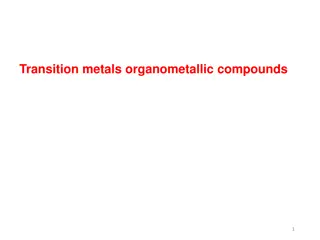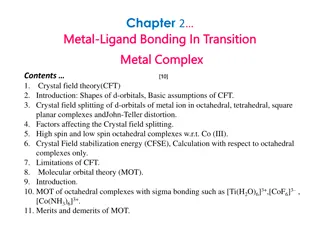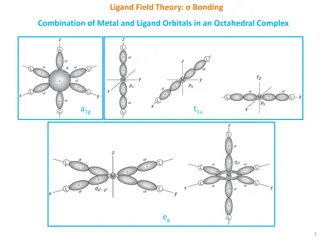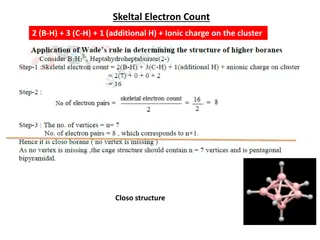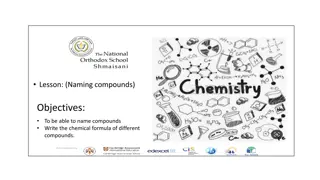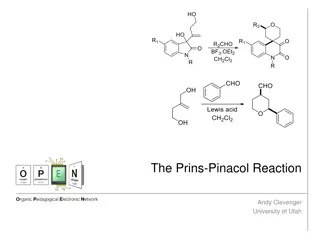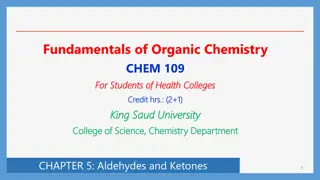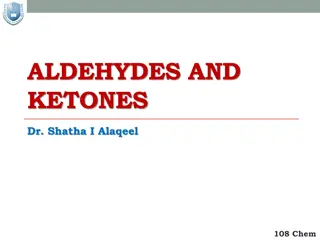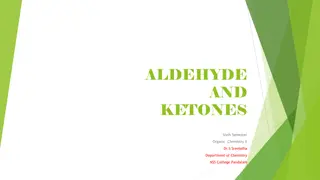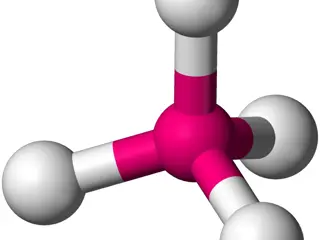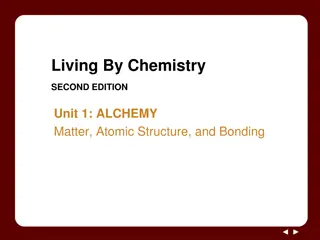Metal Carbonyl Compounds: Properties and Bonding
Metal carbonyl compounds, such as Ni(CO)4 and Fe(CO)5, play a crucial role in industrial processes and have unique bonding modes with carbon monoxide. These compounds exhibit diverse structures and synthesis methods, making them essential in various applications. Understanding their properties and bonding interactions is key to their widespread use in organic compound production and modeling oxygen absorption processes. Explore the structures, synthesis routes, and bonding characteristics of metal carbonyl compounds for a deeper insight into their significance in chemistry.
Download Presentation

Please find below an Image/Link to download the presentation.
The content on the website is provided AS IS for your information and personal use only. It may not be sold, licensed, or shared on other websites without obtaining consent from the author.If you encounter any issues during the download, it is possible that the publisher has removed the file from their server.
You are allowed to download the files provided on this website for personal or commercial use, subject to the condition that they are used lawfully. All files are the property of their respective owners.
The content on the website is provided AS IS for your information and personal use only. It may not be sold, licensed, or shared on other websites without obtaining consent from the author.
E N D
Presentation Transcript
Researching Chemistry ADVANCED HIGHER CHEMISTRY UNIT 3
In this unit you will cover Techniques Gravimetric Analysis Skills Colorimetry Volumetric Analysis Distillation Refluxing Vacuum Filtration Recrystallisation TLC Melting and Mixed Melting Point Stoichiometric Calculations
Key Areas oGravimetric Analysis oVolumetric Analysis oPractical skills and Techniques oStoichiometric Calculations
Experiments covering these areas Experiment 7A and B Preparation and Determination of Aspirin (Stoichiometric Equations) Experiment 10 Colorimetric Determination of Manganese in Steel (Skills and Techniques) Experiment 3 Determination of Nickel in a Nickel (II) salt using EDTA (Volumetric Analysis) Experiment 6 Determination of Vitamin C (Skills and Techniques) Experiment 9 Preparation of Ethyl Ethanoate (Skills and Techniques) Experiment 1 Determination of Ethanoic Acid Content in Vinegar (Volumetric Analysis)
Gravimetric Analysis In gravimetric analysis, the mass of an element or compound present in a substance is determined by chemically changing that substance into some other substance of known chemical composition, which can be readily isolated, purified and weighed to constant mass. You should be aware of the techniques of weighing by difference and heating to a constant mass. This technique is used when an insoluble product is formed.
% by mass and volume and ppm To make a % by mass solution simply weigh out the required mass and make up to 100cm3with distilled water. Eg 1% starch is 1g starch in 100cm3water % by volume is the number of cm3of solute made up to 100cm3of solution. Eg 20% vol H2O2is 20cm3in 100cm3 The unit ppm stands for parts per million and refers to 1 mg per kg.
Gravimetric Analysis The principle behind gravimetric analysis is that the mass of an ion in a pure compound can be determined and then used to find the mass percent of the same ion in a known quantity of an impure compound. There are a number of principles: 1. The ion being analysed must be completely precipitated. 2. The precipitate must be a pure compound. 3. The precipitate must be easily filtered
Volumetric Analysis A solution of accurately known concentration is known as a standard solution. A standard solution can be prepared directly from a primary standard. A primary standard must have, at least, the following characteristics: 1. high state of purity 2. stability in air and in solution 3. solubility 4. reasonably high formula mass
Complexometric Titration Complexometric titration is a form of volumetric analysis in which the formation of a coloured complex is used to indicate the end point of a titration. Complexometric titrations are particularly useful for the determination of a mixture of different metal ions in solution.
Primary Standards Examples of primary standards include: osodium carbonate, Na2CO3 ooxalic acid, H2C2O4.2H2O opotassium hydrogen phthalate, KH(C8H4O4) osilver nitrate, AgNO3 opotassium iodate, KIO3 opotassium dichromate, K2Cr2O7 Certain compounds such as sodium hydroxide are not acceptable as primary standards.
Stoichiometry Stoichiometry is the calculation of relative quantities of reactants and products in chemical reactions. This is based on the law of conservation of mass where the total mass of the reactants equals the total mass of the products leading to the insight that the relations among quantities of reactants and products typically form a ratio. This means that if the amounts of the separate reactants are known, then the amount of the product can be calculated. Conversely, if one reactant has a known quantity and the quantity of product can be empirically determined, then the amount of the other reactants can also be calculated.
Colorimetry/accurate dilution Colorimetry uses the relationship between colour intensity of a solution and the concentration of the coloured species present. A calibration curve must be prepared using solutions of known concentrations (standard solutions). The concentration of the unknown solution is determined from its absorbance and by referring to the calibration curve. The straight line section of the calibration graph should cover the dilution range likely to be used in the determination.
Distillation In the modern organic chemistry laboratory, distillation is a powerful tool, both for the identification and the purification of organic compounds. The boiling point of a compound determined by distillation is well-defined and thus is one of the physical properties of a compound by which it is identified. Distillation is used to purify a compound by separating it from a non-volatile or less-volatile material. This technique provides opportunities for learners to become familiar with glassware containing ground glass joints.
Refluxing Refluxing is a technique used to apply heat energy to a chemical reaction mixture over an extended period of time. The liquid reaction mixture is placed in a round-bottomed flask along with anti-bumping granules with a condenser connected at the top. The flask is heated vigorously over the course of the chemical reaction; any vapours given off are immediately returned to the reaction vessel as liquids when they reach the condenser.
Vacuum filtration Using a Buchner, Hirsch or sintered glass funnel. These methods are carried out under reduced pressure and provide a faster means of separating the precipitate from the filtrate. The choice of filtering medium depends on the quantity and nature of the precipitate.
Recrystallisation Recrystallisation is a laboratory technique used to purify solids, based upon solubility. The solvent for recrystallisation must be carefully selected such that the impure compound is insoluble at lower temperatures, yet completely soluble at higher temperatures. The impure compound is dissolved gently in the minimum volume of hot solvent then filtered to remove insoluble impurities. The filtrate is allowed to cool slowly to force crystallisation. The more soluble impurities are left behind in the solvent.
Use of a separating funnel Solvent extraction can be an application of the partition of a solute between two liquids. It is based on the relative solubility of a compound in two different immiscible liquids, usually water and an organic solvent. The partition coefficient is expressed as the concentration of a solute in the organic layer over that in the aqueous layer. The two solvents form two separate layers in the separating funnel and the lower layer is run off into one container and the upper layer is poured out into another container. The quantity of solute extracted depends on the partition coefficient and on the number of times that the process is repeated.
TLC Thin Layer Chromatography Instead of chromatography paper, thin-layer chromatography (TLC) uses a fine film of silica or aluminium oxide spread over glass or plastic. Rf values can be calculated and under similar conditions a compound will always have the same Rf value within experimental error. Since a pure substance will show up as only one spot on the developed chromatogram, TLC can be used to assess the purity of a product prepared in the lab.
Determination of melting point and mixed melting point The melting point of an organic compound is one of several physical properties by which it can be identified. A crystalline substance has a sharp melting point falling within a very small temperature range. Determination of the melting point can also give an indication of the purity of an organic compound, as the presence of impurities lowers the melting point and extends its melting temperature range. Since impurities lower the melting point, the technique of mixed melting point determination can be used as a means of identifying the product of a reaction. Mixed melting point works by mixing a sample of pure compound (with known melting point) with a sample of the experimental compound. If the melting point is the same as the pure compound then the experimental compound is also pure.
Experiment Preparation and Determination of Aspirin Aspirin has the following structural formula: Since it is insoluble in water, aspirin has to be determined by a back titration technique. This involves treating a sample of accurately known mass with a definite amount of sodium hydroxide, ie the volume and concentration of the alkali must be accurately known. The alkali first catalyses the hydrolysis of the aspirin to ethanoic and salicylic acids and then neutralises these acids. The overall equation for the reaction is: An excess of alkali has to be used and the amount remaining after reaction is determined by titrating it against a standard solution of sulfuric acid. This titration is the back titration.
Experiment - Colorimetric Determination of Manganese in Steel Colorimetry is an analytical technique used to determine the concentrations of coloured substances in solution. It relies on the fact that a coloured substance absorbs light of a colour complementary to its own and the amount of light it absorbs (absorbance) is proportional to its concentration. Colorimetry is particularly suited to the determination of manganese in steel because the manganese can be converted into permanganate ions, which are coloured. The conversion is achieved in two stages. Using nitric acid, the manganese is first oxidised to manganese(II) ions, which are then oxidised to permanganate ions by the more powerful oxidising agent, potassium periodate.
Complexometric Titration Complexometric titration is a form of volumetric analysis in which the formation of a coloured complex is used to indicate the end point of a titration. Complexometric titrations are particularly useful for the determination of a mixture of different metal ions in solution.
Determination of Nickel in a Nickel (II) salt using EDTA The molecule ethylenediaminetetraacetic acid (EDTA) has the following structure. This is an example of complexometric titration. EDTA is a hexadentate ligand which binds in a 1:1 ratio with most metal ions. The co-ordination with number is 6. The reaction is not a simple acid-alkali neutralisation. The murexide indicator is a different colour when free than when it is joined to the Ni2+ ion. Initially the indicator is bound weakly to the Ni ions then binds with more strength to the EDTA ligand.
Determination of Nickel in a Nickel (II) salt using EDTA Since EDTA forms stable complexes with most metal ions, it is widely used to determine metals in what are known as complexometric titrations. The reaction of nickel(II) ions with EDTA can be represented as Y4 + Ni2+ NiY2 The end-point of an EDTA complexometric titration can be detected by means of a metal ion indicator an organic dye which changes colour when it binds with metal ions. For it to be suitable in an EDTA titration, the indicator must bind less strongly with metal ions than does EDTA. Murexide is one such indicator.
Safety Wear eye protection and if any chemical splashes on the skin, wash it off immediately. Hydrated nickel(II) sulfate is harmful by ingestion and inhalation. Wear gloves. EDTA is only toxic if ingested in large quantities. 0.88 aqueous ammonia is toxic if inhaled in high concentrations or if swallowed. The solution and vapour irritate the eyes. The solution burns the skin. Wear goggles and gloves and handle it in a fume cupboard. 1 mol l 1ammonium chloride is harmful and irritates the eyes. Murexide is harmful by ingestion and if inhaled as a dust.
Procedure 1. Transfer approximately 2.6 g of hydrated nickel(II) sulfate to a weighing bottle and weigh the bottle and contents. Add about 25 cm3of deionised water to a 100 cm3beaker and transfer the bulk of the nickel salt to the water. 2. 3. Reweigh the bottle with any remaining salt. Stir the mixture until the solid dissolves and transfer the resulting solution to a 100 cm3 standard flask. 4. 5. Rinse the beaker several times with a little deionised water and add the rinsings to the standard flask. 6. Make up the solution to the graduation mark with deionised water. Stopper the flask and invert it several times to ensure the contents are thoroughly mixed. Rinse the burette with 0.010 mol l 1EDTA and fill it with the same solution. 7.
Procedure 2 Rinse the 20 cm3pipette with a little of the nickel salt solution and pipette 20 cm3of it into a conical flask. Dilute the solution to about 100 cm3with deionised water. 8. 9. Add murexide indicator (approximately 0.05 g) to the diluted nickel salt solution together with approximately 10 cm3of ammonium chloride solution. Titrate the mixture with the EDTA solution and after the addition of about 15 cm3make the solution alkaline by adding approximately 10 cm3of 0.88 aqueous ammonia (concentrated ammonia solution). 10. 11. Continue the titration to the end-point, which is shown by the first appearance of a blue-violet colour. Detection of the end-point can be difficult so keep this titrated solution to help you detect end-points in subsequent titrations. 12. Repeat the titrations until two concordant results are obtained.
Results Titration Trial 3 4 1 2 Initial Burette readings/cm3 Final Titre volume/cm3 Mean titre volume/cm3
Questions Calculate the theoretical percentage by mass of nickel in NiSO4.6H2O Calculate the percentage by mass of nickel in the sample of hydrated nickel(II) sulfate using the stoichiometric equation and your experimental results. Account for the difference in your answers to (a) and (b).
Experiment - Determination of Vitamin C Vitamin C (ascorbic acid) is an important component of our diet. Although it occurs naturally in many fruits and vegetables, many people take vitamin C tablets to supplement their intake. The vitamin C content of a tablet can be determined by carrying out a redox titration with a standard solution of iodine using starch solution as indicator: The equation for the reaction is shown below:
Experiment - Preparation of Ethyl Ethanoate
Experiment - Determination of Ethanoic Acid Content in Vinegar
Use of a balance + gravimetric analysis 1. A laboratory manual contains the following excerpt: Determining the purity of copper carbonate by Gravimetric analysis 1) Record the mass of a crucible (with lid). 2) Weigh out accurately approximately 4g of copper carbonate into the crucible and note the total mass. 3) Heat the crucible strongly for 5 minutes. 4) Let the crucible and contents cool in a desiccator and record the total mass. 5) Repeat steps 3 and 4 until a constant mass is achieved (within 0.002g) (a) Explain the phrase accurately approximately 4g. (b) Explain the reason for cooling the crucible and contents in a desiccator.
Answers 1. (a) The actual mass must be noted accurately and must be close to 4g. (b) The desiccator prevents the sample reabsorbing water from the atmosphere as it cools.
Use of a balance + gravimetric analysis (c) The copper carbonate decomposes according to the following equation: CuCO3(s) CuO (s) + CO2(g) 3.950g of the impure copper carbonate sample was heated and dried to a constant mass of 2.630g (i) Calculate the number of moles of CO2(g) given off. (ii) Using your answer to part (i), how many moles of copper carbonate were in the original sample? (iii) Calculate the % (by mass) of copper carbonate in the impure sample.
Answers (c) (i) 3.950 2.630 = 1.320g of CO2given off. GFM of CO2= 44g n = m/GFM So 1.320/44 = 0.030 moles of CO2 (ii) 1 mole of CuCO3 1 mole of CO2so 0.030 moles of CuCO3 (iii) GFM of CuCO3= 123.5g m = n x GFM 0.03 x 123.5 = 3.705g % purity = (mass of CuCO3/mass of impure sample) x 100% (3.705/3.950) x 100% = 93.8% pure
Use of a balance + gravimetric analysis 1. A sample of hydrated nickel sulphate has the formula NiSO4.xH2O. When a 4.90g sample is heated strongly, the water is quantitatively removed leaving 3.10g of anhydrous nickel sulphate. Calculate the value of x 2. The concentration of a solution of sodium bromide can be determined by gravimetric analysis. A 25cm3sample of the solution to be tested is pipetted into a 100cm3standard flask and made up to the mark with distilled water. This solution is poured into a beaker, the flask is rinsed and this is also added to the beaker. An excess of silver(I) nitrate solution is then added. The silver bromide produced is filtered off, washed and dried. The dry mass of silver bromide, AgBr was 1.05g (a) Why is gravimetric analysis a suitable technique for this analysis? (b) Calculate the concentration of the original sodium bromide solution.
Answers 1. Mass of water removed = 1.8g GFM H2O = 18g moles of water = 0.1 moles Mass of NiSO4remaining = 3.1g GFM NiSO4= 154.8 moles of NiSO4= 0.02 moles 0.1/0.02 = 5 there are 5 moles of H2O for every 1 mole of NiSO4 x=5 NaBr (aq) + AgNO3(aq) NaNO3(aq) + AgBr (s) 2. (a) An insoluble solid (a precipitate) is produced and it can be filtered off, dried and weighed. (b) Mass of AgBr = 1.05g GFM AgBr = 187.8g moles of AgBr = 0.00559 moles 1 mole NaBr (aq) 1 mole AgBr (s) so moles of NaBr = 0.00559 moles 0.00559 moles of NaBr were in 100cm3of diluted solution so the concentration of the c = n/v = 0.00559/0.1 diluted solution was: = 0.0559 moll-1 The dilute solution was produced by diluting the original solution by a factor of 4 (25cm3was to 100cm3) made up Concentration of original solution = 0.0559 x 4 = 0.224 moll-1
Complexometric Complexometrictitration titration 3.43g of NiSO4.6H2O was dissolved in water and made up to 100cm3in a standard flask. 20cm3of this solution was titrated against a 0.101 moll-1solution of EDTA using murexide as an indicator. The results are shown below. 1sttitre 2ndtitre 3rdtitre Rough titre Initial burette reading/cm3 Final burette reading/cm3 0.0 0.0 24.6 0.0 24.8 24.6 48.8 24.3 Volume of EDTA added/cm3 24.8 24.6 24.2 24.3 (a) Calculate the average volume of EDTA which should be used in subsequent calculations. (b) Calculate the percentage of nickel present in the hydrated salt from these experimental results. (c) The theoretical percentage of nickel is 22.3%. Suggest a reason for the difference between the theoretical value and the calculated value from part (b).
Answers (24.2 + 24.3)/2 = 24.25 cm3 within 0.2 of the other accurate values. (a) don t include the rough titre or the non-concordant titre as 24.6 is not (b) Volume of EDTA = 24.25 cm3, concentration of EDTA = 0.101 moll-1 use n = c x v Moles of EDTA = 0.101 x 0.02425 = 0.002449 moles 1 mole nickel reacts with 1 mole of EDTA so moles of nickel = 0.002449 moles 20cm3out of a 100cm3sample was analysed so the total moles of Ni in the original sample was: 5 x 0.002449 = 0.01225 moles 1 mole of Nickel = 58.7g m = n x GFM 0.01225 x 58.7 = 0.7191g of Ni in original sample Percentage of Ni in original sample = (mass of nickel/mass of sample) x 100% % Ni = (0.7191/3.43) x 100% = 21.0% (c) The value is lower than expected due to the sample of nickel sulphate being impure (or other reasonable suggestion).
Complexometric Complexometrictitration titration An experiment was conducted to identify which halogen is present in a magnesium halide compound (MgX2). 2.08g of the pure compound was dissolved in water and made up to 200cm3 in a standard flask. 20cm3portions of this were titrated against EDTA (0.035 moll-1) and the average titre was 32.3cm3. Magnesium ions react with EDTA in a 1:1 ratio. Identify X.
Answers Concentration of EDTA = 0.035 moll-1volume of EDTA = 32.3 cm3use n=c x v Moles of EDTA = 0.035 x 0.0323 = 0.001131 moles 1 mole of Mg2+reacts with 1 mole of EDTA so moles of Mg2+in portion analysed = 0.001131 moles Moles of Mg2+in entire sample = 0.001131 x 10 = 0.01131 moles The original sample was produced by dissolving MgX2so 2.08g of MgX2is 0.01131 moles of MgX2 (one Mg per formula unit) 0.01131 moles of MgX2 1 mole of MgX2 2.08 x (1/0.01131) = 183.7g So GFM of MgX2= 183.7g Mg has a mass of 24.3 so 159.45 is due to X2 So X has a mass of 159.45/2 = 79.7 The closest match is bromine (79.9) X = Br 2.08g
Back Back titrations titrations A student was asked to determine the concentration of ammonia, NH3, a volatile substance, in a commercially available cloudy ammonia solution used for cleaning. First the student pipetted 25.00 cm3of the cloudy ammonia solution into a 250.0 cm3conical flask. 50.00 cm3of 0.100 moll-1HCl (aq) was immediately added to the conical flask which reacted with the ammonia in solution. The excess (unreacted) HCl was then titrated with 0.050 moll-1Na2CO3 (aq). 21.50 cm3of Na2CO3 (aq) was required. (a) Write balanced chemical equations for the reaction of ammonia with HCl and the reaction of HCl with Na2CO3. (b) Calculate the concentration of the ammonia in the cloudy ammonia solution.
Answer HCl (aq) + NH3(aq) NH4Cl (aq) This is often written as follows to emphasise the neutralisation reaction occurring (and a solution of ammonia is sometimes referred to as an ammonium hydroxide solution as these ions are in equilibrium with ammonia and water molecules): HCl (aq) + NH4OH (aq) NH4Cl (aq) + H2O (l) Either way the mole ratio is 1:1 2HCl (aq) + Na2CO3(aq) 2NaCl (aq) + CO2(g) + H2O (l)
Answer Calculate total moles of HCl added: n = 0.100 x 0.05000 = 0.00500 moles Now calculate the number of moles of HCl which reacted with the titration data: Moles of Na2CO3= 0.05 x 0.0215 = 0.001075 moles 2 moles HCl reacts with 1 mole Na2CO3, so moles of HCl in excess = 0.00215 moles Moles of HCl which reacted with NH3= 0.00500 - 0.00215 = 0.00285 moles 1 mole NH3reacts with 1 mole HCl, so moles of NH3= 0.00285 moles Concentration of cleaning solution = n /v = 0.00285 / 0.025 = 0.114 moll-1
Back Titrations Marble is a form of calcium carbonate, CaCO3, and it can be analysed for purity by adding an excess of HCl (aq) and then titrating the unreacted HCl with NaOH (aq). CaCO3(s) + 2HCl (aq) CaCl2(aq) + H2O (l) +CO2(g) HCl (aq) + NaOH (aq) NaCl (aq) + H2O (l) A student is developing a method to perform this analysis. She has prepared standard solutions of HCl (0.505 moll-1) and NaOH (0.225 moll-1) and weighed out 1.04g of marble. Calculate what volume of her HCl (aq) solution she should use so that when she titrates the unreacted HCl, the volume of NaOH (aq) required is 25cm3. For this calculation you may assume the marble is 100% CaCO3.
Answer GFM of CaCO3= 100.1g, mass = 1.04g n = m/GFM n = 1.04 / 100.1 = 0.01039 moles 2 moles HCl react with 1 mole CaCO3 So moles of HCl needed to neutralise CaCO3= 0.01039 x 2 = 0.02078 moles Calculate moles of HCl in excess which is titrated with NaOH: Moles of NaOH = c x v = 0.225 x 0.025 = 0.005625 moles 1:1 ratio of NaOH to HCl, so moles of HCl = 0.005625 moles Total moles of HCl required = 0.02078 + 0.005625 = 0.02641 moles Volume of HCl required = n/c = 0.02641 / 0.505 = 0.0523 litres = 52.3 cm3
Colorimetry Colorimetryand serial and serial dilution dilution Solutions containing permanganate ions have a deep purple colour. Explain why a wavelength such as 520nm is an appropriate choice when analysing such a solution using colorimetry. You may wish to use page 20 of the data book to assist you. Calculate the resulting concentration, in moll-1, when solutions are diluted in the following ways: 20 cm3of a 1.5 moll-1solution of HCl is made up to 250 cm3with deionised water in a standard flask. 4cm3of a 0.005 moll-1solution of KMnO4is made up to 50 cm3with deionised water in a standard flask. 25 cm3of a 0.8 moll-1solution of Na2SO4is made up to 100 cm3with deionised water in a standard flask and the resulting solution is then diluted by a factor of 10.



